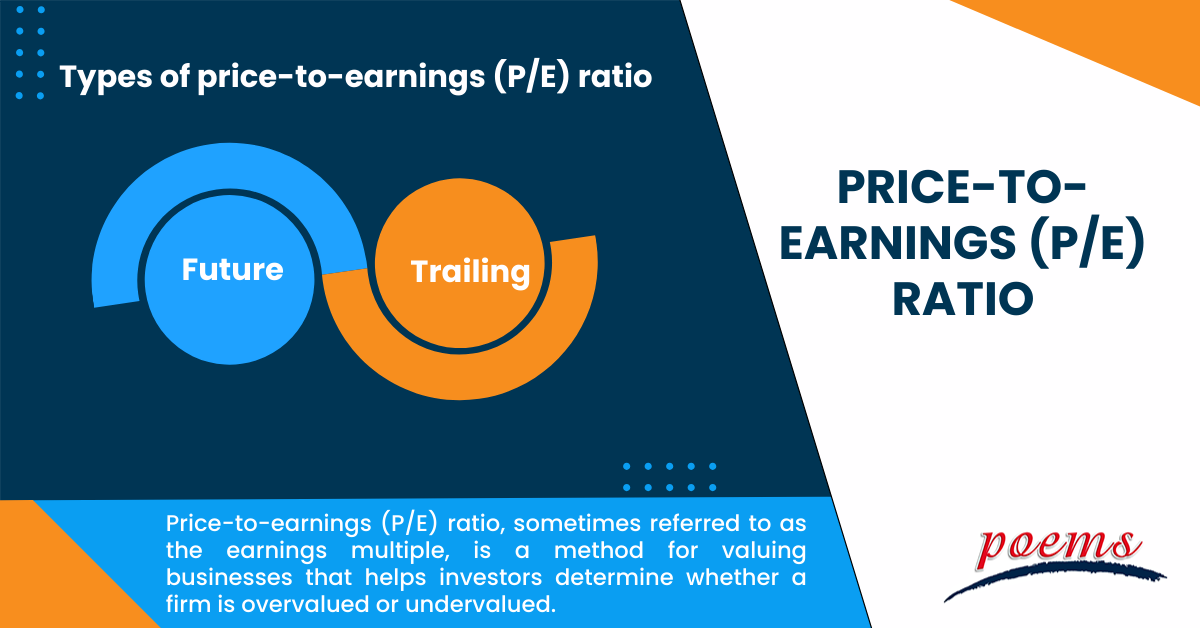Price-to-earnings (P/E) ratio
Table of Contents
Price-to-earnings (P/E) ratio
Investors evaluate companies from various angles in their search for reliable stocks. The viewpoints can be strengthened by using different analysis. One technique that can assist you in determining a stock’s fair market value is fundamental analysis.
Fundamental analysis forms the foundation for numerous ratios. The price-to-earnings ratio (P/E ratio) is an important measure that investors use to evaluate a company from a valuation standpoint.
What is price-to-earnings (P/E) ratio?
Price-to-earnings (P/E) ratio, sometimes referred to as the earnings multiple, is a method for valuing businesses that helps investors determine whether a firm is overvalued or undervalued.
Financial indicators that examine a firm’s earnings, such as P/E ratios, are crucial because they help investors and investment bankers make judgments and reveal whether a company is or will be profitable.
Using the price-to-earnings ratio, one can assess how a company stacks up against rivals in the same sector. P/E ratios of various firms can be compared to determine a better investment.
To better understand a company’s growth and potential future growth, the P/E ratio can also be compared to the company’s historical performance.
Understanding the price-to-earnings (P/E) ratio
The price-to-earnings Ratio (P/E) is one of the measures that analysts and investors use most frequently to determine a stock’s relative value. You can decide if a stock is overvalued or undervalued using its P/E ratio. A company’s P/E ratio can also be contrasted with other stocks in the same industry or the market, such as the S&P 500 Index.
The P/E 10 or P/E 30 metrics, which average the last 10 or prior 30 years of earnings, are occasionally considered by analysts interested in long-term valuation patterns. When calculating the total worth of stock indices like the S&P 500, these longer-term metrics are typically used since they can take the business cycle into account.
P/E ratio formula and calculation
The key equation for determining a company’s trailing P/E ratio is:
P/E ratio = cost per share/earnings per share
This formula reads:
The stock’s current market price is the cost per share, or the price associated with purchasing one share of a corporation.
Earnings per share (EPS) is the annual net profit divided by the number of outstanding shares for a corporation (shares of common stock issued to investors). A future P/E analysis considers expected earnings from analysts and the company itself, whereas a trailing P/E analysis bases the earnings per share on the last 12 months of earnings.
The P/E ratio of a corporation is usually shown in the form of an “x” (such as 20x or 15x), which denotes how often the stock price is greater than the earnings per share. A company’s P/E ratio is 30/1 or 30x if its stock trades at $30 per share and earns $1 per share annually.
All that reveals is that the corporation makes $1 annually for every $30 in stock. Or, it would take 30 years for the company to make enough money to reimburse the share price assuming the stock price and earnings remained unchanged.
Types of price-to-earnings (P/E) ratio

The types of price-to-earnings (P/E) ratios are as follows:
- Future P/E ratio
It is computed by dividing the prices of a company’s shares of stock by the company’s projected earnings as indicated by its forward-looking earnings projection. This type of ratio is also known as an estimated P/E Ratio because it is based on a company’s expected future earnings.
- Trailing P/E ratio
Investors commonly use the trailing P/E Ratio, which looks at a company’s historical earnings over a given period. This offers a more precise and impartial picture of a company’s performance.
Example of price-to-earnings (P/E) ratio
To better understand the price-to-earnings (P/E) ratio, let’s look at the following example:
If Stock X is trading at $30 and Stock Y is at $20, Stock X is not necessarily more costly. From a value perspective, the P/E ratio might help us choose which of the two is less expensive.
Even though Stock X has a greater absolute price than Stock Y, if the sector’s average P/E is 15, Stock X is more affordable since you pay less for every $1 in current earnings. However, Stock Y has a larger ratio than its rival and the industry. This could imply that investors anticipate future earnings growth higher than the market average.
Frequently Asked Questions
The P/E ratios opposite is the earnings yield. The P/E ratio shows the investor how long it would take for the firm to maintain its earnings to reach the current share price, whereas the earnings yield informs a shareholder how much he has earned per share held.
Price-to-earnings growth (PEG) and price-to-earnings (PE) ratios are fairly comparable. The company’s stock price about its earnings-per-share can be understood using both ratios (EPS). The PEG ratio includes the anticipated growth rate in earnings, which is the only distinction between the two measures.
High P/E ratios on stocks may indicate that investors anticipate future profit growth to be higher. Stocks with low P/E ratios are tempting to value investors because they suggest they pay less for each dollar of earnings they receive, in contrast to stocks with high P/E ratios, which are attractive to growth investors.
The P/E ratio’s major drawback is that it gives investors little information about the likelihood of the company’s EPS growing. If a firm expands swiftly, you will feel confident purchasing it even if its P/E ratio is high because you know that EPS growth will drive the P/E back down to a more reasonable level.
If the P/E ratio is negative, the company is either losing money or reporting negative earnings. Even the most well-established companies occasionally experience downtime, which can be brought on by factors outside the company’s control.
Related Terms
- Mark-to-market
- Federal Open Market Committee
- FIRE
- Applicable federal rate
- Assets under management
- Automated teller machine
- Central limit theorem
- Balanced scorecard
- Analysis of variance
- Annual percentage rate
- Double Taxation Agreement
- Floating Rate Notes
- Average True Range (ATR)
- Constant maturity treasury
- Employee stock option
- Mark-to-market
- Federal Open Market Committee
- FIRE
- Applicable federal rate
- Assets under management
- Automated teller machine
- Central limit theorem
- Balanced scorecard
- Analysis of variance
- Annual percentage rate
- Double Taxation Agreement
- Floating Rate Notes
- Average True Range (ATR)
- Constant maturity treasury
- Employee stock option
- Hysteresis
- RevPAR
- REITS
- General and administrative expenses
- OPEX
- ARPU
- WACC
- DCF
- NPL
- Capital expenditure (Capex)
- Balance of trade (BOT)
- Retail price index (RPI)
- Unit investment trust (UIT)
- SPAC
- GAAP
- GDPR
- GATT
- Irrevocable Trust
- Line of credit
- Coefficient of Variation (CV)
- Creative Destruction (CD)
- Letter of credits (LC)
- Statement of additional information
- Year to date
- Certificate of deposit
- Individual retirement account (IRA)
- Quantitative easing
- Yield to maturity
- Rights of accumulation (ROA)
- Letter of Intent
- Return on Invested Capital (ROIC)
- Return on Equity (ROE)
- Return on Assets (ROA)
Most Popular Terms
Other Terms
- Physical ETF
- Initial Public Offering
- Buyback
- Secondary Sharing
- Bookrunner
- Notional amount
- Negative convexity
- Jumbo pools
- Inverse floater
- Forward Swap
- Underwriting risk
- Reinvestment risk
- Final Maturity Date
- Payment Date
- Secondary Market
- Margin Requirement
- Pledged Asset
- Yield Pickup
- Subordinated Debt
- Trailing Stops
- Treasury Stock Method
- Stochastic Oscillator
- Bullet Bonds
- Basket Trade
- Contrarian Strategy
- Exchange Control
- Notional Value
- Relevant Cost
- Dow Theory
- Speculation
- Stub
- Trading Volume
- Going Long
- Pink sheet stocks
- Rand cost averaging
- Sustainable investment
- Stop-limit sell order
- Economic Bubble
- Ask Price
- Constant prepayment rate
- Covenants
- Stock symbol
- Companion tranche
- Synthetic replication
- Bourse
- Beneficiary
- Witching Hour
- Widow and Orphan stock
- Public Float
- Closing Price
Know More about
Tools/Educational Resources
Markets Offered by POEMS
Read the Latest Market Journal

Back in Business: The Return of IPOs & Top Traded Counters in March 2024
Start trading on POEMS! Open a free account here! At a glance: Major indices continue...

Weekly Updates 15/4/24 – 19/4/24
This weekly update is designed to help you stay informed and relate economic and company...

From $50 to $100: Unveiling the Impact of Inflation
In recent years, inflation has become a hot topic, evoking strong emotions as the cost...

Japan’s Economic Resurgence: Unveiling the Tailwinds Behind Nikkei 225’s Record Leap
Source: eSignal, Intercontinental Exchange, Inc. In the heart of Japan’s economic landscape, the Nikkei 225...

Weekly Updates 8/4/24 – 12/4/24
This weekly update is designed to help you stay informed and relate economic and...

What Makes Forex Trading Attractive?
In a world where the click of a button can send goods across oceans and...

Weekly Updates 1/4/24 – 5/4/24
This weekly update is designed to help you stay informed and relate economic and company...

How to soar higher with Positive Carry!
As US Fed interest rates are predicted to rise 6 times this year, it’s best...












